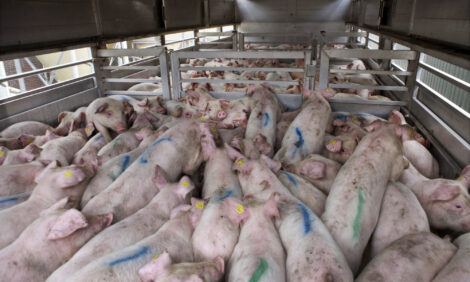



CME: Hog Producers Stay Ahead of the Flow of Hogs
US - Cattle futures closed sharply lower while Hog slaughter rose up to 2.277 million head on the previous week but is still 52,000 head lower from December 1, write Steve Meyer and Len Steiner.Nearby live cattle futures closed sharply lower again on
Friday afternoon, capping a disastrous week for cattle values.
The nearby February live cattle contract has lost 800
points or 6 per cent compared to where it traded two weeks ago.
April and June contracts also have been down sharply. That
little seed of doubt about the ability of the beef cutout to break
convincingly above the $200 mark now has flowered into a full
blown panic attack.
The choice beef cutout closed at $189.8/cwt
on Friday, $4 lower than the previous week. Packers have found
it difficult to bid up beef prices as beef supplies remain stubbornly
above year ago levels.
Different than
with cattle, hog producers continue to stay ahead of the flow of
hogs and weights remain quite current. USDA pegged hog carcass weights at 207 pounds per carcass, compared to 209 a year ago.
It is likely that USDA will revise this number higher in the
coming weeks. The data from the Mandatory reporting program
currently has hog carcass weights at around 208 pounds per carcass.
Hog futures have held up quite well despite the pullback in
cattle prices. While pork prices at retail continue to struggle,
especially loin cuts, other pork items have done quite well.
Pork
belly values remain exceptionally strong at this time of year, up
some 20 per cent from the already high prices of a year ago. Pork trim
values have been languishing.
In part this may have to do with
the lack of export business with Russia. Also, it appears that
plenty of pork is going into the 72CL combos, as evidenced by the
spread between the price of straight 72CL trim to the price of
72CL picnics. Bottom line: Pork at this point is in a firmer footing than cattle.
Beef supplies are increasing despite
fewer cattle coming to market. As we note on page 2, total weekly
cattle slaughter was estimated at 615,000 head, down 0.7 per cent from
year ago levels.
However, the average carcass weight of all cattle
now stands at 803 pounds, about 25 pounds or 2.7 per cent higher than a
year ago. Total beef production for the week was about 2 per cent higher
than the same week a year ago.

Steer and heifer slaughter for
the week was estimated at 472,000 head, 0.8 per cent lower than a year
ago while cow slaughter for the week at about 143,000 head was
down 0.6 per cent compared to last year. The slump in the cutout appears to be following the same pattern as a year ago.
After
splurging over the holidays, consumers appear to be in no mood to
pay more for beef at the retail case.
But more importantly, unless
we get a surge in beef export demand, it will be difficult to get the
kind of premiums in cattle that futures were calling for a few
weeks ago while at the same time bringing more beef to market
than a year ago.
Cattle slaughter is expected to decline in the
coming weeks but the heavy weight will blunt some of the decline
in numbers.
Hog slaughter for the week was 2.227 million head,
0.47 per cent higher than a year ago. Since December 1, however, hog
slaughter has been down 52,000 head or 0.3 per cent from a year ago.
This is slightly behind the pace implied by the December 1 Hogs
and Pigs survey but the difference is quite small.







